Abstract
A randomised, controlled, double-blind clinical trial designed to determine the effectiveness of phenytoin in preventing epilepsy in patients who had suffered a serious head injury is reported. One hundred and sixty-four patients were randomly assigned to treatment with phenytoin or placebo capsules for one year. Patients who had a fit within one week of injury were excluded. Drug levels were monitored throughout with appropriate dosage adjustment; however only 48% of the phenytoin group had plasma levels greater than 40 mumol/l. There were seven deaths during the study. Only 11 patients (six in the phenytoin group and five in the placebo group) developed post-traumatic epilepsy within one year; a further four patients developed seizures between 1 and 2 years after injury. This low incidence of post-traumatic epilepsy (7% (SE 2%) at one year and 10 (SE 2%) at two years) means that future clinical trials of prophylaxis will have to be much larger (at least six fold).
Full text
PDF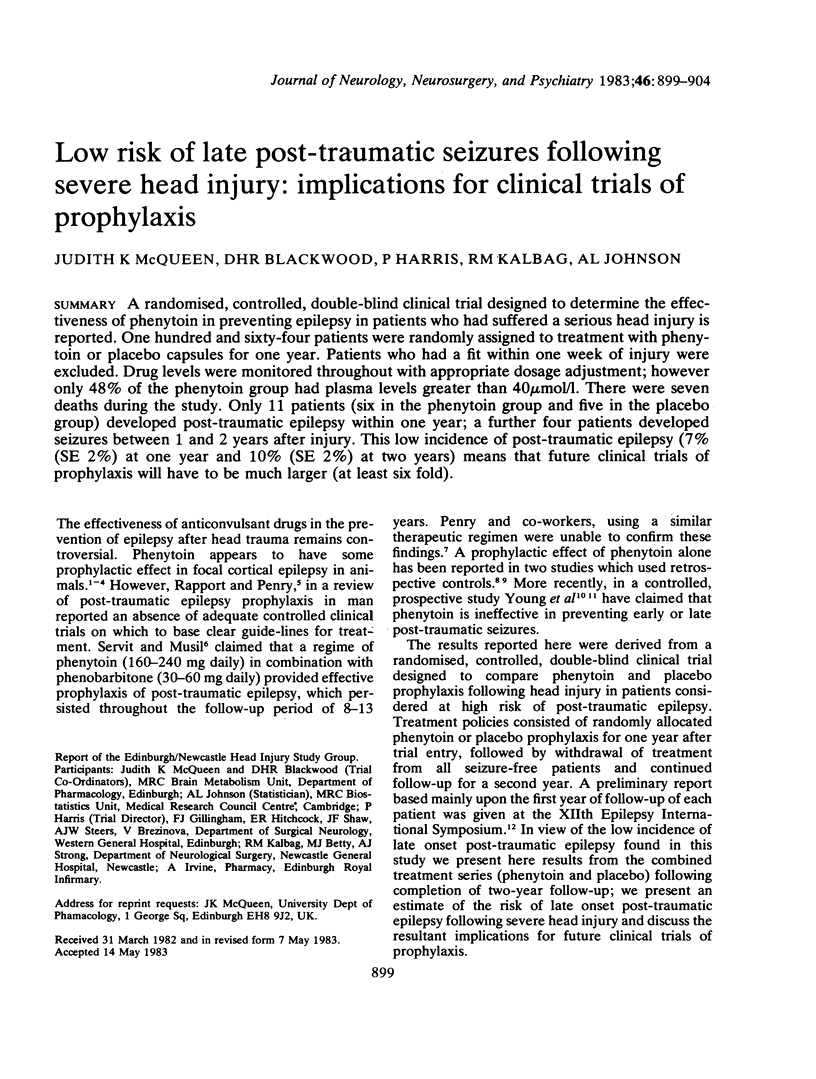
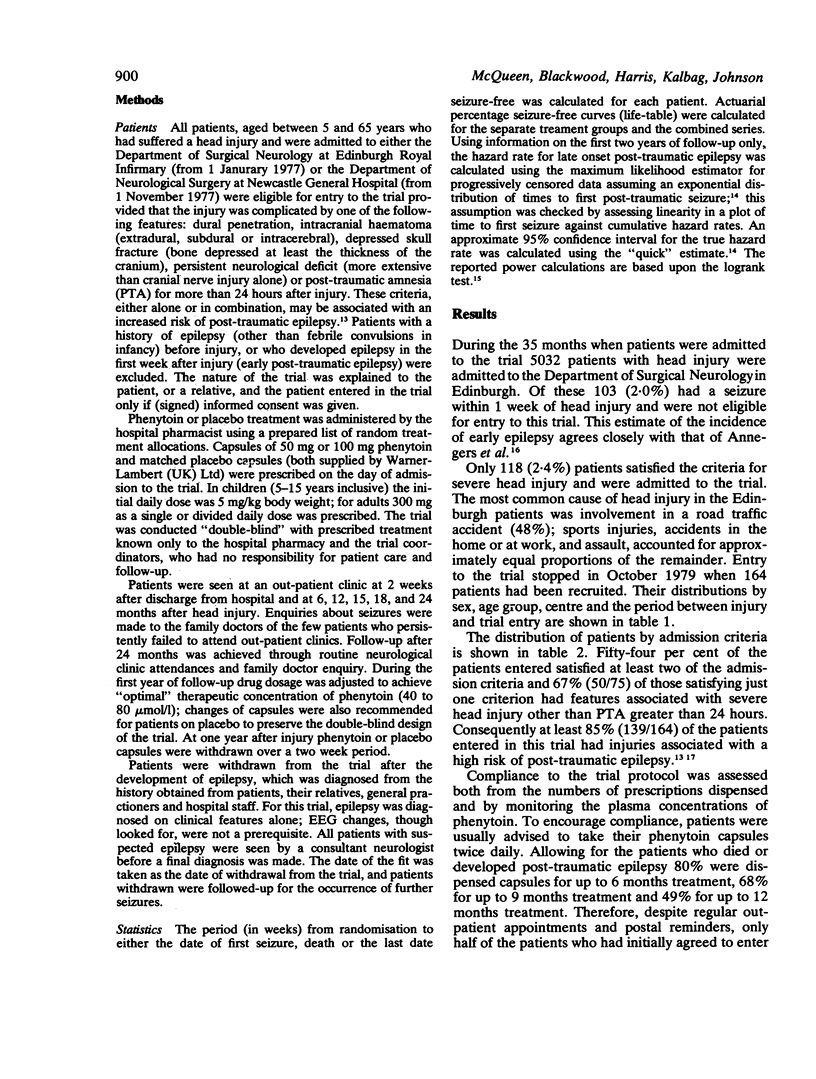
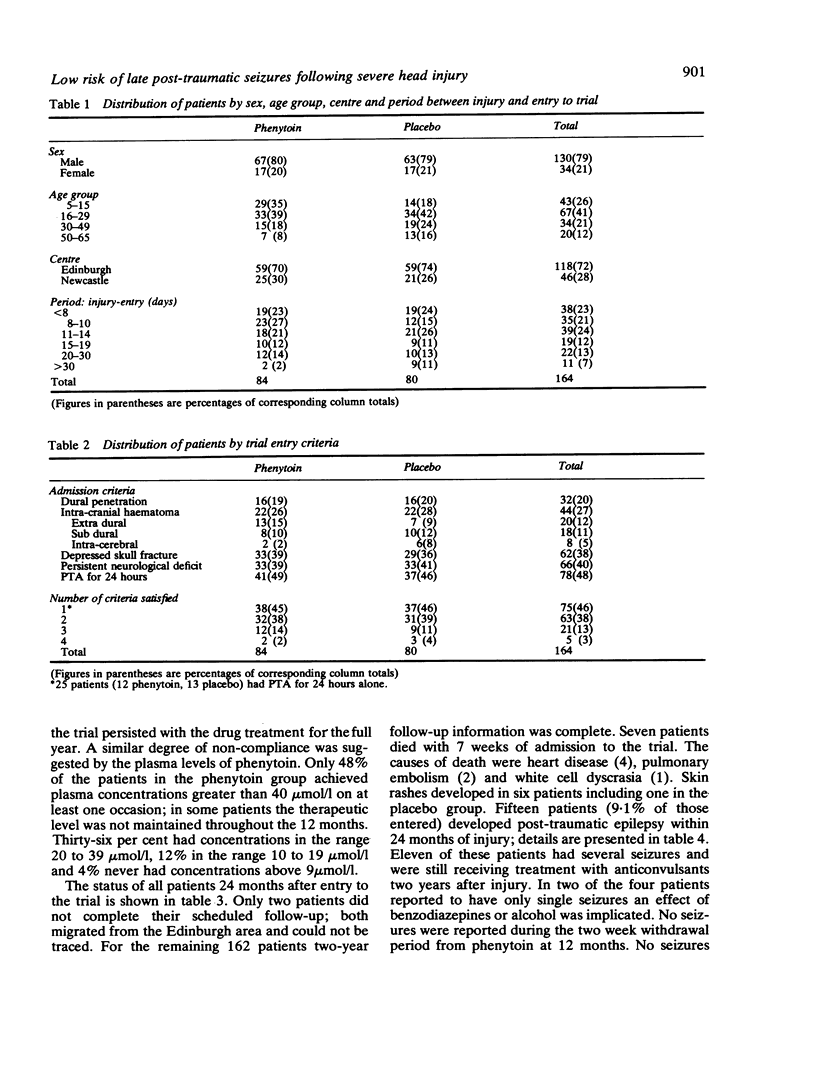
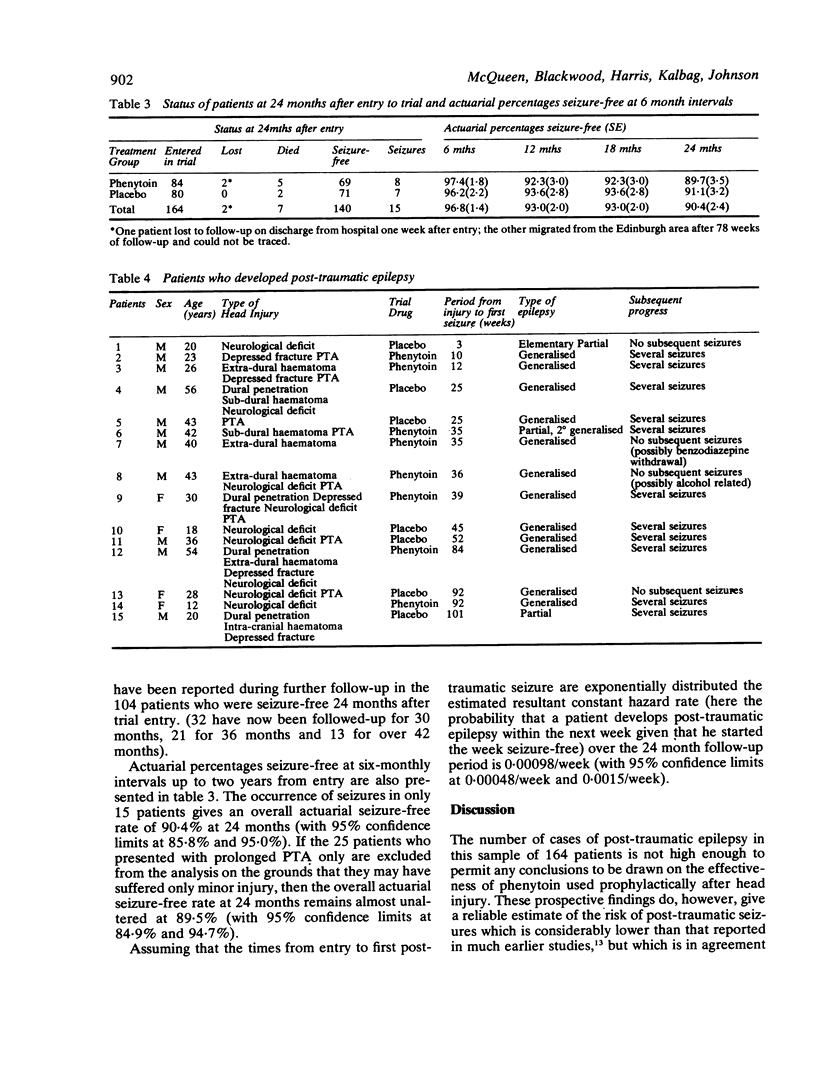

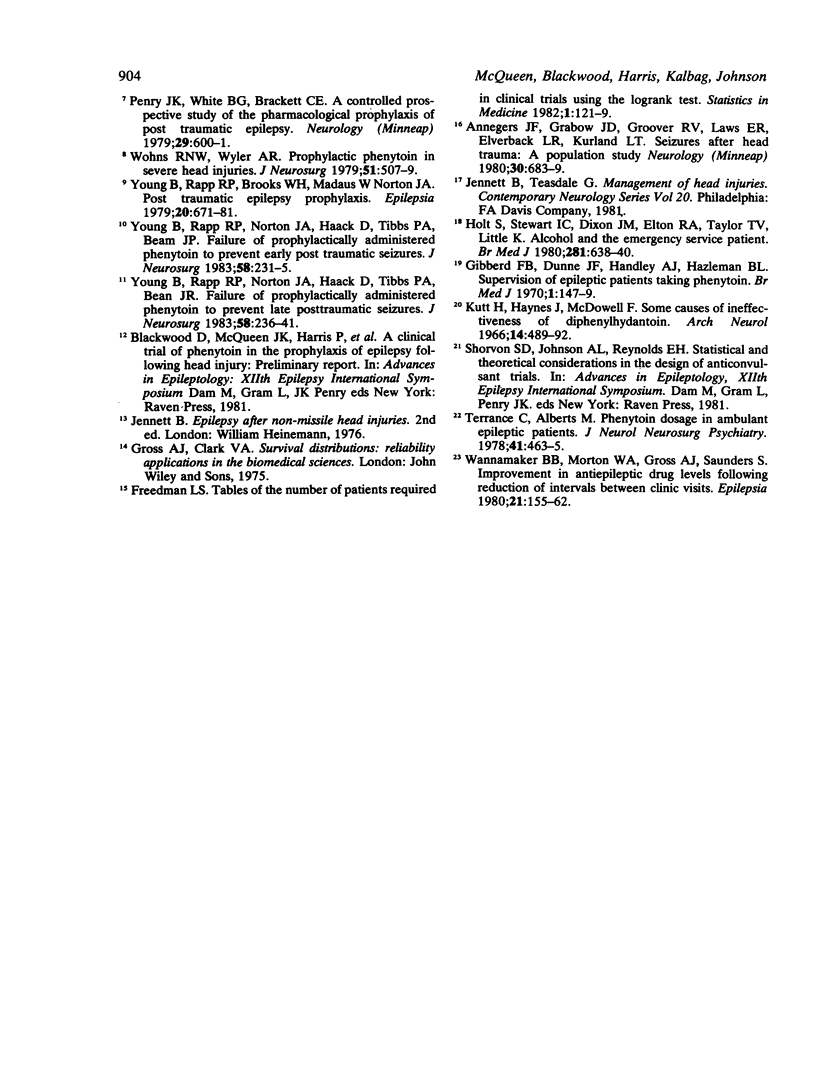
Selected References
These references are in PubMed. This may not be the complete list of references from this article.
- Annegers J. F., Grabow J. D., Groover R. V., Laws E. R., Jr, Elveback L. R., Kurland L. T. Seizures after head trauma: a population study. Neurology. 1980 Jul;30(7 Pt 1):683–689. doi: 10.1212/wnl.30.7.683. [DOI] [PubMed] [Google Scholar]
- Freedman L. S. Tables of the number of patients required in clinical trials using the logrank test. Stat Med. 1982 Apr-Jun;1(2):121–129. doi: 10.1002/sim.4780010204. [DOI] [PubMed] [Google Scholar]
- Gibberd F. B., Dunne J. F., Handley A. J., Hazleman B. L. Supervision of epileptic patients taking phenytoin. Br Med J. 1970 Jan 17;1(5689):147–149. doi: 10.1136/bmj.1.5689.147. [DOI] [PMC free article] [PubMed] [Google Scholar]
- Holt S., Stewart I. C., Dixon J. M., Elton R. A., Taylor T. V., Little K. Alcohol and the emergency service patient. Br Med J. 1980 Sep 6;281(6241):638–640. doi: 10.1136/bmj.281.6241.638. [DOI] [PMC free article] [PubMed] [Google Scholar]
- Kutt H., Haynes J., McDowell F. Some causes of ineffectiveness of diphenylhydantoin. Arch Neurol. 1966 May;14(5):489–492. doi: 10.1001/archneur.1966.00470110033004. [DOI] [PubMed] [Google Scholar]
- Lockard J. S., Congdon W. C., DuCharme L. L., Huntsman B. J. Prophylaxis with diphenylhydantoin and phenobarbital and alumina-gel monkey model. I. Twelve months of treatment: seizure, EEG, blood, and behavioral data. Epilepsia. 1976 Mar;17(1):37–47. doi: 10.1111/j.1528-1157.1976.tb03380.x. [DOI] [PubMed] [Google Scholar]
- MORRELL F., BRADLEY W., PTASHNE M. Effect of drugs on discharge characteristics of chronic epileptogenic lesions. Neurology. 1959 Jul;9(7):492–498. doi: 10.1212/wnl.9.7.492. [DOI] [PubMed] [Google Scholar]
- Racine R., Livingston K., Joaquin A. Effects of procaine hydrochloride, diazepam, and diphenylhydantoin on seizure development in cortical and subcortical structures in rats. Electroencephalogr Clin Neurophysiol. 1975 Apr;38(4):355–365. doi: 10.1016/0013-4694(75)90260-6. [DOI] [PubMed] [Google Scholar]
- Rapport R. L., 2nd, Ojemann G. A. Prophylactically administered phenytoin. Effects on the development of chronic cobalt-induced epilepsy in the cat. Arch Neurol. 1975 Aug;32(8):539–548. doi: 10.1001/archneur.1975.00490500059007. [DOI] [PubMed] [Google Scholar]
- Rapport R. L., 2nd, Penry J. K. Pharmacoligic prophylaxis of posttraumatic epilepsy. A review. Epilepsia. 1972 Apr;13(2):295–304. doi: 10.1111/j.1528-1157.1972.tb05264.x. [DOI] [PubMed] [Google Scholar]
- Servít Z., Musil F. Prophylactic treatment of posttraumatic epilepsy: results of a long-term follow-up in Czechoslovakia. Epilepsia. 1981 Jun;22(3):315–320. doi: 10.1111/j.1528-1157.1981.tb04115.x. [DOI] [PubMed] [Google Scholar]
- Terrence C., Alberts M. Phenytoin dosage in ambulant epileptic patients. J Neurol Neurosurg Psychiatry. 1978 May;41(5):463–465. doi: 10.1136/jnnp.41.5.463. [DOI] [PMC free article] [PubMed] [Google Scholar]
- Wannamaker B. B., Morton W. A., Jr, Gross A. J., Saunders S. Improvement in antiepileptic drug levels following reduction of intervals between clinic visits. Epilepsia. 1980 Apr;21(2):155–162. doi: 10.1111/j.1528-1157.1980.tb04057.x. [DOI] [PubMed] [Google Scholar]
- Wohns R. N., Wyler A. R. Prophylactic phenytoin in severe head injuries. J Neurosurg. 1979 Oct;51(4):507–509. doi: 10.3171/jns.1979.51.4.0507. [DOI] [PubMed] [Google Scholar]
- Young B., Rapp R. P., Norton J. A., Haack D., Tibbs P. A., Bean J. R. Failure of prophylactically administered phenytoin to prevent early posttraumatic seizures. J Neurosurg. 1983 Feb;58(2):231–235. doi: 10.3171/jns.1983.58.2.0231. [DOI] [PubMed] [Google Scholar]
- Young B., Rapp R. P., Norton J. A., Haack D., Tibbs P. A., Bean J. R. Failure of prophylactically administered phenytoin to prevent late posttraumatic seizures. J Neurosurg. 1983 Feb;58(2):236–241. doi: 10.3171/jns.1983.58.2.0236. [DOI] [PubMed] [Google Scholar]
- Young B., Rapp R., Brooks W. H., Madauss W., Norton J. A. Posttraumatic epilepsy prophylaxis. Epilepsia. 1979 Dec;20(6):671–681. doi: 10.1111/j.1528-1157.1979.tb04851.x. [DOI] [PubMed] [Google Scholar]


